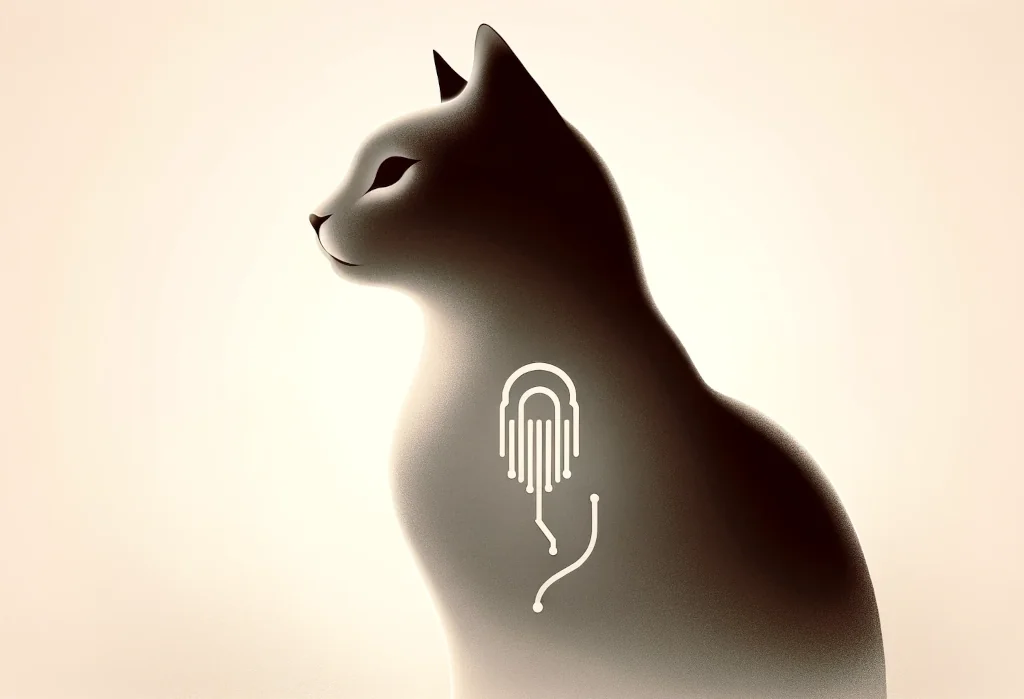Cats are infamous escape artists, and when Mr. Whiskers slips out for his unexpected adventure, we’re left with our hearts in our throats. Sure, a collar with a tag is a start, but what if there’s a foolproof way to bring your furry Houdini home safe and sound?
This blog post will give you the lowdown on microchipping your cat – it’s the upgrade your peace of mind has been waiting for.
Key takeaways:
- Microchipping provides a permanent ID for your cat, greatly increasing the chances of reunion if lost.
- The procedure is quick, similar to a vaccination, and has a strong track record of safety.
- Remember to register the chip and keep your contact information updated to ensure its effectiveness.
What Is a Microchip and How Does It Work?
When it comes to keeping your feline friend safe, microchipping is like hitting the jackpot in terms of pet identification. So, what’s this all about? Think of a microchip as a permanent ID badge that your cat can never lose. This tiny device, about the size of a grain of rice, is implanted just under your kitty’s skin, typically between the shoulder blades.
Here’s the techy bit: the microchip itself doesn’t have a battery or any moving parts – it’s dormant until a scanner waves over it. This powers up the chip, allowing it to transmit a unique ID number to the scanner.
It’s like your cat giving a secret handshake that says, “This is who I am, and I have a home!” Should your whiskered wanderer ever get lost and is brought to a shelter or vet, the microchip can be scanned, and voilà – your contact details pop up from a registered database, and you’re one step closer to a happy reunion.
Now, you might be wondering, “Is this like GPS?” Not quite – it doesn’t track location, but it’s a crucial tool in helping lost pets find their way back to their humans.
Why Should You Microchip Your Cat?
Let’s cut to the chase: microchipping your cat is a wise move. Here’s why:
- Permanent peace of mind: Unlike collars and tags that can break or fall off, a microchip is a permanent solution. Once it’s in, it’s in for good.
- Proof of ownership: In the off-chance you and another person both claim to be your cat’s owner, a microchip provides indisputable proof. It’s the key to proving your side of the story.
- Easy as pie to update: If you move or change your phone number, updating the contact info linked to your cat’s microchip is a breeze – just a quick update on the microchip registry website, and you’re set.
- Higher rates of success: Microchipped cats are much more likely to find their way back to their owners. In fact, according to a study by the Journal of the American Veterinary Medical Association, they are over 20 times more likely to be returned home than unchipped cats.
Here’s the unique tip you won’t find just anywhere: Create a “Lost Cat” kit now, which should include a recent photo of your cat, a description of their microchip number, and the contact information for your microchip registry. This way, if your cat does get lost, you’re prepared to spring into action without losing a second.
Is Microchipping Safe for Cats?
Now for the question on every pet parent’s mind: is microchipping safe for our purring pals? In short, yes. Here’s the lowdown:
The procedure is a walk in the park – similar to when your cat receives a vaccine. A qualified vet uses a needle to insert the microchip under your cat’s skin, and although there might be a momentary “Ouch!”, it’s quick and typically stress-free.
Side effects? They’re rare, but like any procedure, there can be minor complications. These may include localized swelling or an infection at the injection site, but problems like these are few and far between. The microchip itself is encased in biocompatible material to prevent it from causing irritation or moving around, which means once it’s in place, your cat will hardly know it’s there.
To put your mind at ease even further, a study by the British Small Animal Veterinary Association found that microchipping is a remarkably safe procedure, with only a tiny fraction of animals experiencing adverse effects.
Remember, this isn’t “goodbye” — there’s more to learn and discover about keeping your feline companion safe and sound. Stay tuned for more insights and tips on how to give your cat the best care possible.
How and Where Can You Get Your Cat Microchipped?
When it comes to keeping your furry friend safe, microchipping is the tech-savvy way to go. You might be wondering where to get this quick and simple procedure done. Fear not, it’s pretty straightforward, and you’ve got several options!
Veterinary Offices: The most common place to have your cat microchipped is at your local vet’s office. Just like a regular checkup, you’ll need to book an appointment. Vets are pros at this; they’ll have your kitty chipped in no time, often during regular checkups or other procedures.
Animal Shelters: Many shelters offer microchipping services, sometimes at a reduced cost as part of their commitment to keeping pets safe. You can check out local shelters and inquire whether they offer this service to the public.
Special Events: Keep your eyes peeled for pet fairs or events in your community. These often have microchipping stations set up, and can be a more affordable option, or even provided for free as part of an awareness drive.
Preparing for the big day is a breeze. Ensure your kitty’s well-rested, and maybe slip them a treat or two beforehand to make them feel at ease. During your visit, expect it to be over faster than you can say “here kitty, kitty”. The actual insertion of the chip is super quick and is similar to a routine vaccination.
Remember, when choosing where to get your cat microchipped, consider the credentials and reviews of the provider. You want the best hands on deck for your furry family member.
What Do You Do After Your Cat Is Microchipped?
Congrats on adding a new level of security for your feline buddy! But don’t just sit back and relax yet—there are a couple of important steps to follow through on post-microchipping:
-
Register the Microchip: First and foremost, register the chip with a national pet recovery database. It’s as vital as the chip itself because this is how your cat is identified if they go missing. You’ll get instructions from the vet or shelter, so follow them carefully.
-
Keep Your Info Updated: If you move or change phone numbers, update your contact info ASAP on the microchip registry. It’s the link that brings your cat back to you, so make sure it’s solid.
-
Vet Checkups: Every time your cat has a checkup, ask the vet to scan the microchip to make sure it’s still functioning and hasn’t moved. It’s a quick process, but it’s often forgotten.
-
Awareness: Spread the word to friends and family about the importance of microchipping. It’s surprising how many pet owners aren’t aware of this game-changer.
Here’s a nugget of advice that really makes a difference—create a small reminder in your annual calendar to check and update your microchip information. Life gets busy, and these little details easily slip our minds. This simple habit can be a lifesaver for your pet.
Truth be told, microchipping is a subtle blend of tech and love—a modern solution to an age-old fear of losing our beloved pets. Stay proactive about your kitty’s safety because there’s no such thing as being too careful when it comes to family.
Alex, a passionate animal lover, has experience in training and understanding animal behavior. As a proud pet parent to two dogs and three cats, he founded AnimalReport.net to share insights from animal experts and expand his knowledge of the animal kingdom.





